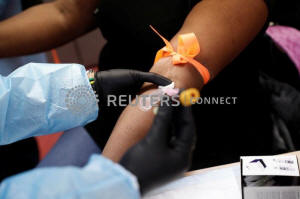Hispanics, African Americans hit hard in U.S. COVID-19 hotspot counties,
says CDC
 Send a link to a friend
Send a link to a friend
 [August 15, 2020]
(Reuters) - U.S. coronavirus
hotspots had disproportionately high numbers of cases among communities
of color, according to an analysis on Friday by the Centers for Disease
Control and Prevention (CDC). [August 15, 2020]
(Reuters) - U.S. coronavirus
hotspots had disproportionately high numbers of cases among communities
of color, according to an analysis on Friday by the Centers for Disease
Control and Prevention (CDC).
The report adds to a growing body of evidence that long-standing health
and social inequities have resulted in increased risk for infection and
death from COVID-19 among communities of color, the CDC said .
In 79 counties identified as hotspots that also had information on race,
96.2% had disparities in COVID-19 cases in one or more minority racial
and ethnic groups between February and June, researchers concluded.
The largest disparities were reported among Hispanic people in hotspot
counties (3.5 million people), followed by African Americans (2
million). Asian populations were disproportionately affected by COVID-19
in a small number of hotspot counties, but the Asian racial category is
broad and further analyses might provide additional insights, the
researchers said.

The study did not assess disparities in COVID-19–related deaths because
of the lack of available county-level mortality data, but the
researchers said existing national analyses show there exists
differences in COVID-19 deaths and similar patterns were likely to exist
at the county level too.
Apart from long-standing discrimination and social inequities, other
factors such as economic and housing policies, employment in meat
packing, agriculture, service and health care sectors, and living in
multifamily households could increase risk for transmission, the
researchers said.
[to top of second column]
|

A woman has her blood taken by Northwell Health medical workers for
the antibody tests that detect whether a person has developed
immunity to the coronavirus disease (COVID-19) at the First Baptist
Cathedral of Westbury in Westbury, New York, U.S., May 13, 2020.
REUTERS/Shannon Stapleton

Researchers pointed out more than half of the hotspot counties did
not report sufficient race data and had to be excluded from the
analysis. Further, health departments differ in the way race and
ethnicity are reported.
These data gaps, combined with differences in access to COVID-19
testing, might limit findings, the researchers said.
Still, the analysis highlights the need to develop culturally
responsive, targeted interventions with organizations within
communities of color to reduce COVID-19 disparities.
(Reporting by Vishwadha Chander in Bengaluru; Editing by Aurora
Ellis)
[© 2020 Thomson Reuters. All rights
reserved.] Copyright 2020 Reuters. All rights reserved. This material may not be published,
broadcast, rewritten or redistributed.
Thompson Reuters is solely responsible for this content.
 |